
THE FACIT BRANCH: ROCHDALE TO BACUP
GEOGRAPHICAL CONTEXT
Bacup is a small Lancashire town in the Borough of Rossendale located near the head of the River Irwell in a valley deeply incised into the moorlands of the South Pennines. Despite its site on the valley floor, Bacup claims to be the highest town in Lancashire, its town centre being about 830ft above sea level, and its former station at 801ft. In England only Alston, Buxton and Consett are thought to be higher. Rossendale Forest was a medieval hunting ‘chase’, including the upper Irwell Valley, its northern tributary valleys and the moorland to the north, but the moors south of the Irwell are also considered by some to be part of Rossendale, and the modern borough extends as far south as Whitworth in the valley of the River Spodden – the ‘Whitworth Valley’ - followed by the Facit Branch railway from Rochdale to Bacup. At the other end of the Facit Branch, Rochdale is much better known as a former centre of the cotton spinning industry and as the birthplace of the Co-operative movement – the initiative of the ‘Rochdale Pioneers’ in 1844. Whereas Bacup and its adjacent settlements have about 13,000 residents, Rochdale is a substantial town with a population of about 212,000.
The floor of the Irwell Valley and several others that join it from the north are occupied by straggling nineteenth century terraces, and on the steep valley sides and moorland edge are scattered cottages and hamlets. Whitworth Valley has a similar character, although it lacks the densely populated tributary valleys. In the twentieth century some of the higher land has acquired housing estates. The moorlands were traditionally used for grazing sheep, and the local people spun and wove the wool in their cottages. In the nineteenth century the Coal Measures beneath the moorlands were exploited in numerous small pits, and huge sandstone quarries were hollowed out of the plateau, as found above Britannia and Facit, while in the valleys the woollen industry gave way to cotton, and the domestic manufacture yielded to production in mills. The textile industry of Bacup and the other upper Irwell Valley settlements developed in a unique fashion, specialising in the manufacture of carpet slippers. Although this industry, along with more conventional textile production, has all but ceased, many of the stone-built former industrial premises are still standing and, appropriately for Rossendale, between Rawtenstall and Bacup some now operate as footwear showrooms and cash-and-carry outlets. In character the valleys surrounding Bacup have more than a passing resemblance to those of South Wales.
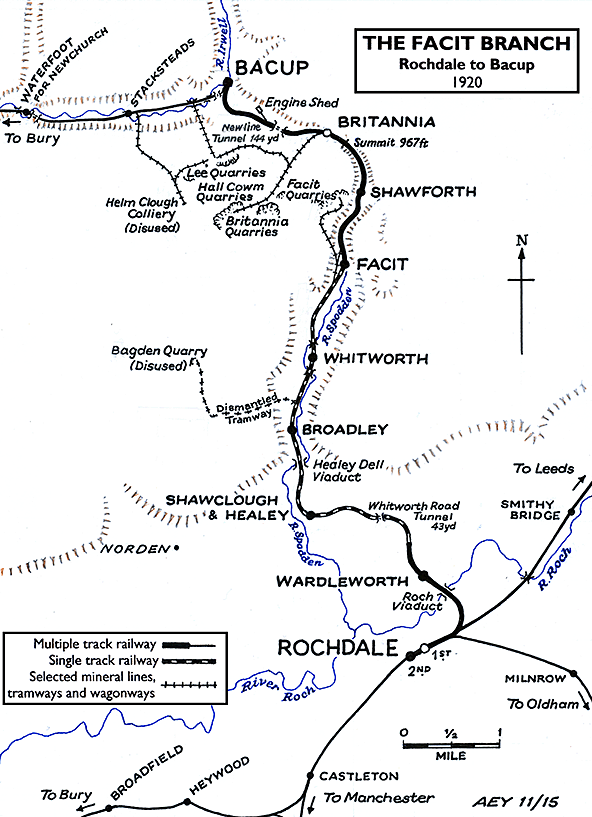
Bacup acquired an unusual railway layout, its station being the terminus of two branches which diverged towards Rawtenstall and Bury (opened 1852) via the Irwell valley, and to Rochdale via the Whitworth Valley. The latter route, generally known as the Facit Branch after one of its intermediate stations (opened throughout in1881), set out from Bacup on a punishing uphill gradient as steep as 1 in 34 as it conquered the watershed at Britannia between the Irwell and Whitworth valleys, and in the process required a short tunnel and ascended to 967ft – the highest point on the Lancashire & Yorkshire Railway. It is no surprise that in severe winter weather the cutting at Britannia summit could become choked with snow; in the winters of 1940 and 1947 trains were stranded there for several days.
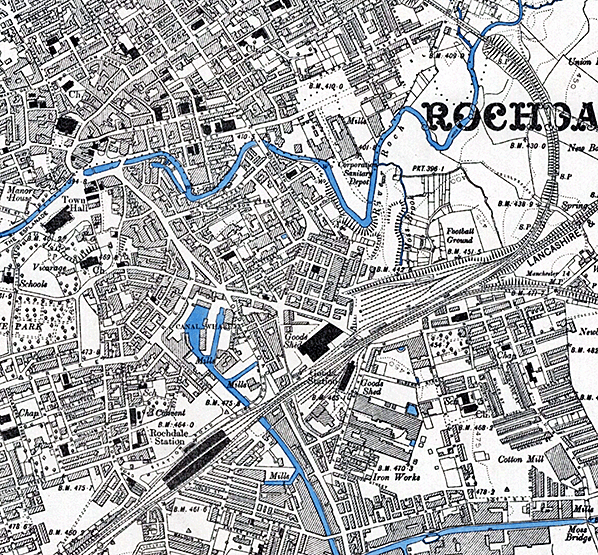
1890 1: 10,560 OS map. The ‘Facit Branch’ leaves the Manchester-Leeds main line at the eastern edge of this map. Rochdale station is named; the original site of the town’s station was to the north-east, between the Goods Shed and Goods Station, both of which are named. The Facit Branch is carried on a curving embankment towards the Roch Viaduct, at the northern edge of the map
CONSTRUCTION OF THE BRANCH TO FACIT
Construction of a railway from Rochdale through Whitworth to Bacup was approved by the passing of the Manchester & Leeds Railway Act (1846). A second survey of the route was reported in 1847, but no further progress was made and the project lapsed. In 1847 the Manchester & Leeds became the major component of the newly-formed Lancashire & Yorkshire Railway (LYR). In the early 1860s a plan for a line from Oldham to Rochdale and Bacup was revealed by the Oldham, Ashton & Guide Bridge Junction Railway and in response the LYR extended its Oldham branch through Shaw to Rochdale (opened 1863) and also proposed a route from its station at Rochdale to Shawforth (about 3 miles south of Bacup) which was approved by an Act of 30 June 1862. Owing to the greed and uncooperativeness of landowners along the route progress was slow, but eventually a construction contract was awarded on 16 June 1865 to Messrs Barnes & Beckett for £82,500 and work began in August with a view to completion in June 1869. The engineer to the project was Sturges Meek, Chief Civil Engineer to the Lancashire & Yorkshire Railway.
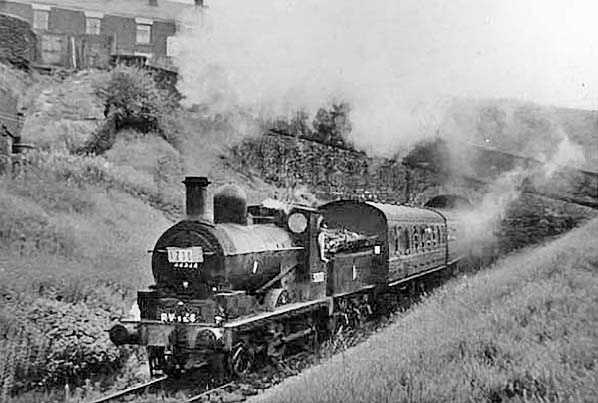
On 28 July 1962 the Roch Valley Railway Society’s ‘Salford Hundred Railtour’ visited Facit, hauled there by No.52523 and returning to Rochdale behind No.40063. Here No.52523 is emerging from the short Whitworth Road Tunnel. The Aspinall-designed Class LYR27 0-6-0 was built in July 1909 at Horwich works. Numbered 636 by the LYR she was renumbered 12523 by the LMS. In September 1962 she would be withdrawn from 26C, Bolton shed and disposed of by Campbells, Shieldhall in May 1963
The six miles from Rochdale to Shawforth were within the Whitworth Valley, and it was necessary to cross the River Spodden at several points. Two notable viaducts and significant earthworks were required to take the railway across the rough terrain: these were the Roch Viaduct, named after the river crossed between Rochdale and Wardleworth stations, and Healey Dell Viaduct crossing the Spodden in its ravine between Shawclough and Broadley. Also between these stations there were problems with an embankment where an underline bridge had been constructed. The unstable embankment began to slither down the hillside towards Heap Mill Reservoir, taking the bridge with it, and eventually, when the slip was stabilised, a second bridge was built to carry the railway. Both bridges exist side-by-side today, only yards apart; they are sometimes described as the ‘Siamese’ (i.e. conjoined twin) bridges. Cuttings near Broadley caused problems and required some minor realignment of the route north of this station. Only one level crossing over a public road was provided on the line, over Tong Lane at Tong End Fold (where the signal box was called Tonge End) midway between Whitworth and Facit stations.
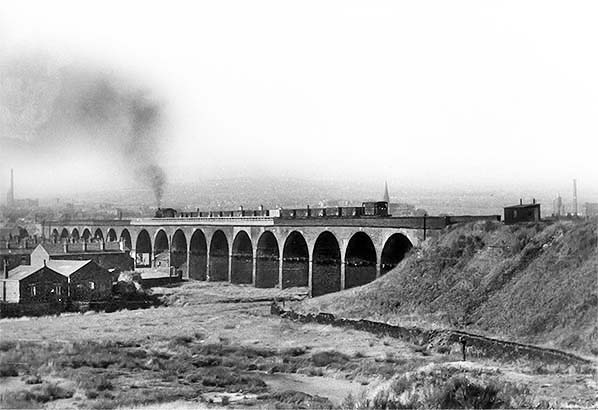
Ivatt Class 2F 2-6-0 No.46406 is heading north-westwards across the 18 arches of the Roch Viaduct with the afternoon branch freight on Tuesday 6 October 1959. It looks as though the long train of wagons is being taken to Wardleworth goods yard, and that the engine and brake will then proceed to Shawclough & Healey; this was normal for the afternoon freight, which ran about 2pm. The loco was built in December 1946 at BR Crewe works. She was withdrawn from 26A, Newton Heath shed, on 31 January 1967 and cut up by Cashmores, Newport, the following September
Photo by Richard S Greenwood from Whitworth Historical Society
Construction of the Roch Viaduct was not straightforward: one pier had to be dismantled and rebuilt twice and other piers also needed remedial work. There were also problems with the embankment at the north end of viaduct as the spoil used in its construction, extracted from cuttings at Broadley, proved to be quicksand which turned into slurry, spreading in every direction when it was tipped from a height of 36ft, endangering the stability of the viaduct. At one stage when over 200 wagon-loads per day were being tipped the embankment failed to advance. The completed viaduct was 270yd long, standing 45ft above the River Roch. It consisted of 18 brick arches; 17 were of 37ft 4in span and the other was a skew span of 45ft across the river.
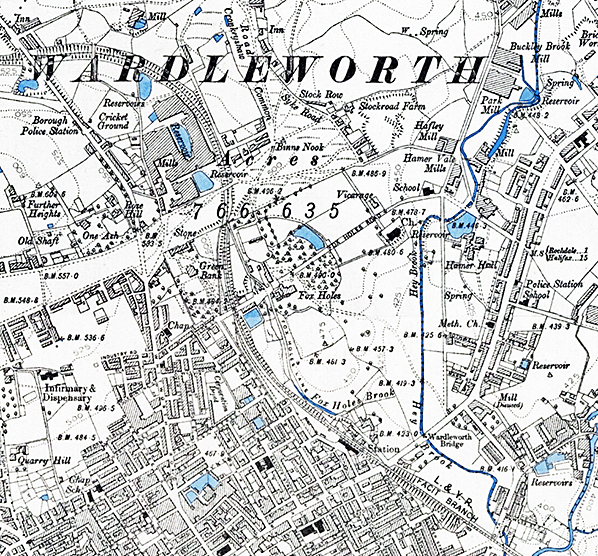
1890 1: 10,560 OS map. Where the Facit Branch enters the map at the southern edge it is passing over the Roch Viaduct. After crossing Yorkshire Street by a bridge, the line enters Wardleworth passenger station (shown simply as ‘Station’), and goods are handled in the sidings north-west of the station. At this date the railway forms the boundary of Rochdale’s continuously built-up area. To the west of the line, where it describes a broad curve, are John Bright’s Fieldhouse Mills. The Facit Branch is double-track as far north as Wardleworth’s goods sidings, and thereafter is single track as far as Facit. The line leaves the map as it passes under Whitworth Road by a short tunnel
A 60ft-span iron bridge was required in Rochdale to cross over Yorkshire Street, just south of Wardleworth station.
The most impressive engineering work on the line was – and still is - Healey Dell Viaduct, between Shawclough and Broadley, a graceful slender structure of eight stone arches rising 105ft above the River Spodden, with a further iron span over a road. The construction of this viaduct seems to have been free of major incidents. The Roch Viaduct, although much longer, lacked the charm of Healey Dell’s setting and has been demolished.
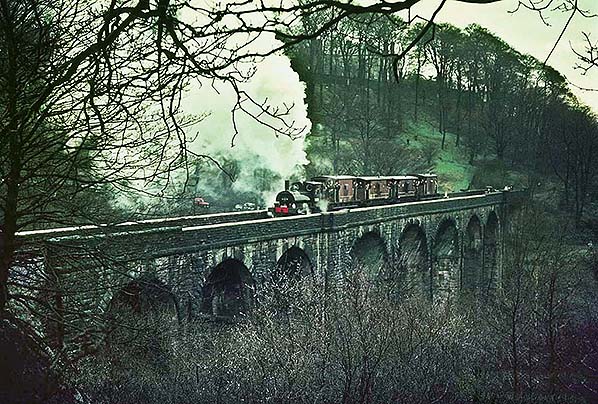
The LCGB and Roch Valley Railway Society ‘L&Y Pug Rail Tour’ crosses the spectacular Healey Dell Viaduct on 19 February 1967 travelling from Rochdale to Whitworth, the terminus of the Facit Branch at this time. Three round trips were made on the tour between Rochdale and Whitworth; four brake vans were hauled by No.51218 and intermediate photo-stops were made at Wardleworth and Shawclough & Healey stations. The locomotive, BR No.51218 is an Aspinall 0-4-0 saddle tank, fondly known as a ‘Pug’. She was built at the LYR Horwich works in October 1901 and as a LYR Class 21 first carried the number 68, being re-numbered 11218 in LMS days. On 30 September 1964 she was withdrawn from 87A, Neath Court Sart shed and was purchased by the L&Y Saddletanks Fund and housed on the Keighley & Worth Valley Railway. The Saddletanks Fund later became the Lancashire & Yorkshire Railway Preservation Society, and more recently the Lancashire & Yorkshire Railway Trust, which
now owns 51218.
Photo by T Baxendale from Kerry Parker's Flickr photostream
All earthworks and bridges between Wardleworth and the terminus at Facit were built for single-track clearances. Seeing that the locality was in the process of industrial growth this is surprising as many other single-track routes in Britain with poorer economic prospects were ‘future-proofed’ by building the structures with double-track dimensions.
Contracts for the stations were let in March 1868; their single-storey buildings were to be of stone, and their locations would be at Wardleworth Brow, Shawclough, Ending, Whitworth and Facit. The station at Ending station was known as Broadley when it opened and it apparently was not provided with a building of any substantial size until the turn of the century. At this stage the 2¼-mile stretch of line beyond Facit to Shawforth was not proceeded with.
OPENING TO FACIT AND EXTENSION TO BACUP
The Rochdale to Facit branch opened to goods traffic on 1 October 1870 and passengers were carried from 1 November. From the opening nine trains ran on weekdays from Rochdale to Facit, with ten returning. On Sunday four trains were provided in each direction. Economic growth in the Whitworth Valley was impressive at this time: in 1870 there were 21 mills in operation between Healey and Shawforth with some 4,000 employees.
Rochdale station had been opened in 1839 by the Manchester & Leeds Railway, its site being east of Oldham Road, but following re-buildings and extensions until the mid 1880s to cope with increasing traffic (including contributions from the Facit branch) it was replaced with a new station west of Oldham Road on 28 April 1889; the new station was 26 chains (572yd) west of its predecessor. The new facility possessed two long island platforms – one for up and the other for down traffic – and there were two bays at the west end of the up platform, and two more at the east end of the down platform, where Facit branch trains would be accommodated. The Facit branch curved away from the main line at Oldham & Facit Junction, later known as Rochdale East Junction. The 20-lever ‘Facit Junction Sidings’ signal box was provided on the down side north of the junction, renamed Rochdale No.7 in 1896. In 1898 the box was replaced with an LYR brick-based box with a 36-lever frame, on the up side; this box was known as Rochdale Branch Sidings by 1912.
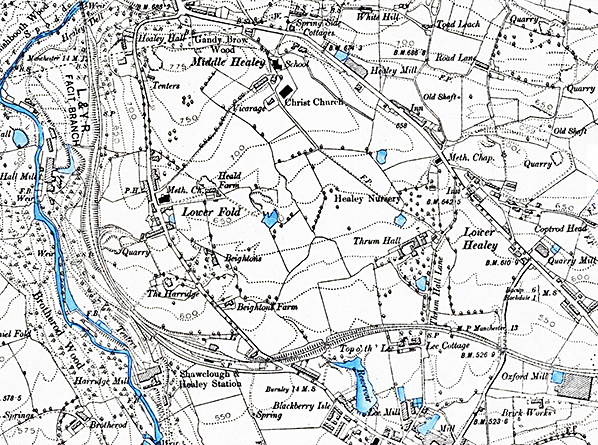
1890 1: 10,560 OS map. The Facit Branch curves across the map, steadily gaining altitude northwards. The single-track line is accompanied by loops and sidings as it passes through Shawclough & Healey station. Although the station’s setting is rural, Harridge textile mill is close-by, served by a siding; this establishment would later become an important asbestos works. Further north a quarry, east of the line, is also rail-served. At the northern edge of the map is Healey Dell Viaduct where the line makes one of its crossings of the River Spodden
On 18 July 1872 the LYR obtained an Act to extend the Facit branch to Bacup. As happened with construction from Rochdale to Facit, work on the extension was seriously delayed as the company negotiated with landowners who made excessive financial demands. Messrs Beckett & Bentley were awarded the construction contract in May 1878, almost a year after the L&Y had intended the line to be completed; the line cost between £140,000 and £150,000 to build. On 23 November 1881 the Board of Trade Inspector, Major General C S Hutchinson, consented to the opening of the 3 mile 104yd extension although the company was told to convert a timber viaduct near Bacup into an embankment as soon as practicable and imposed a 10mph speed limit over it until the conversion was complete. The company had hoped to save about £700 by using the timber viaduct rather than a more robust structure. The line from Facit to Bacup opened without ceremony on 1 December 1881. Although it was now a through line, the route continued to be known as the Facit Branch; Ordnance Survey large scale plans retained this name printed alongside the railway. The use of this name avoided the ambiguity of the ‘Bacup Branch’ since there were, of course two, both of them Lancashire & Yorkshire Railway routes. The accompanying Airey’s map of 1881 shows the Facit Branch extension as ‘projected’; the 1893 map shows it in its completed state.
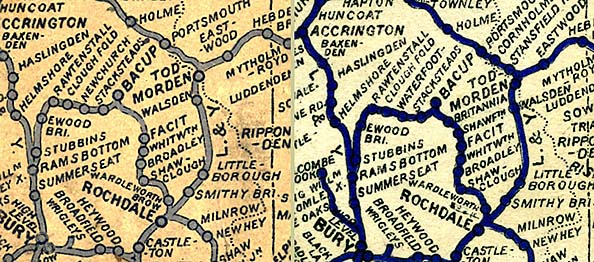
THE LINE AND ITS SIDINGS
The original section of the Rochdale-Bacup branch to Facit was built largely as a single-track route, but it was double at the southern end through Wardleworth, and the single-track section just north of this station was widened to three lines in the 1880s. Extensive goods and mineral facilities were added over the next two decades. From Facit Goods signal box to Bacup the new line was double-track from its opening. On the single-track section trains could pass at Broadley station, but here there was only a single platform, so although a passenger train could pass a goods, two passenger trains could not cross; consequently the frequency at which passenger trains could operate between Rochdale and Bacup was limited.
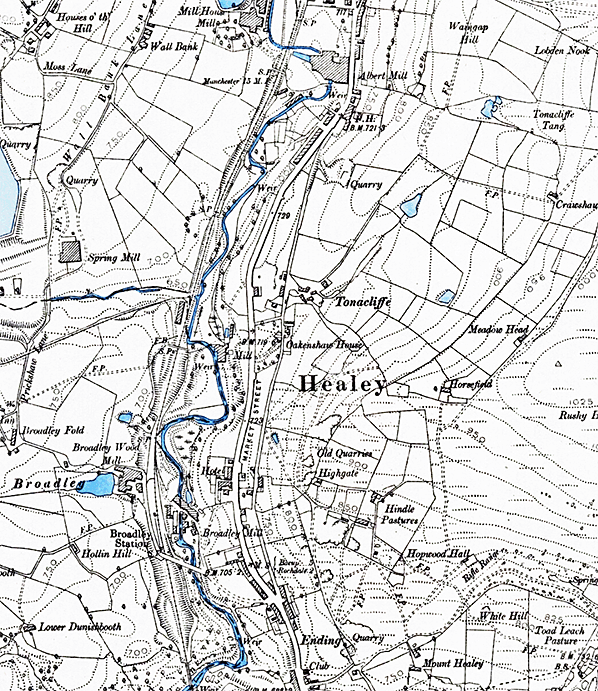
1890 1: 10,560 OS map. The Facit Branch enters the map at the southern edge as it crosses the River Spodden on Healey Dell Viaduct. Immediately north of this viaduct, east of the line a munitions factory and its sidings would be operated in World War 2. Broadley station is in a rural setting, built to serve the village of Ending . Two mills are shown a short distance north of the station. About halfway up the map, north of Broadley station, is Henry Heys’ Broadley stone processing works and siding, and a (narrow gauge) tramway is seen to the west which served Heys’ quarry on the moors. In later years, after Heys ceased to operate the siding, it would be used by Spring Mill (named on this map). The Facit Branch climbs at a continuous gradient of 1 in 60 northwards on this map, with only a short level stretch through Broadley station
A number of industrial establishments were served by sidings at some stage of the railway’s life, and at least three rope-worked inclines connected the branch with quarries several hundred feet aloft on the moors. From south to north, sidings were provided on the Facit Branch to serve:
- Fieldhouse Mills (John Bright & Bros Ltd) north of Wardleworth (1901-1950s)
- Rochdale Brick Co, north of Wardleworth (1912-1950s)
- Turner Bros asbestos works, Shawclough & Healey (1919-1967)
- World War 2 explosives factory, south of Broadley
- Broadley Mill (at Broadley, siding disconnected by 1910)
- Heys Siding (aka Broadley Stone Siding), north of Broadley opened c1886 (closed c1900) re-used by:
- Spring Mill Dyeworks (William Mycock) (1918-1950s)
- Facit quarries (via zig-zag incline) (Henry Heys & Sanderson) (1899-1947)
- Shawforth Quarries (Isaac Law) (c1882-c1913)
- Shawforth Brick Co
- Britannia Stone Siding to moorland quarries (Brooks & Brooks, later Butterworth & Brooks) (c1885 – 1944)
- Rockcliffe Vale Steam Mill (Greenwood) near Bacup loco shed (1882-by 1930)
- Ross Spinning Co near Bacup loco shed (1913-by 1958)
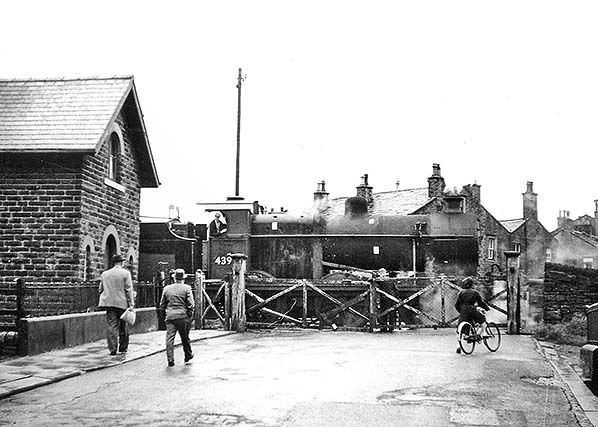 Tonge End (Tong Lane) crossing was midway between Whitworth and Facit stations on the Rochdale-Bacup line. The attractive two-storey stone building with its overhanging roof and arched openings is the crossing keeper’s house (now demolished). The crossing was originally worked from the keeper's house on the east side of the line, but a substantial wooden LYR signal box was provided in 1899 on the west side. The crossing keeper's house remained after the box had been decommissioned. In this north-westward view on 21 July 1962 No.43903 is travelling towards Facit from Whitworth. The loco is a Fowler-designed 4F 0-6-0, built by the Midland Railway in April 1920 at Derby works. Numbered 3903 in LMS ownership the ‘4’ prefix was added by British Railways. No.43903 was withdrawn from 16C, Kirkby-in-Ashfield shed, on 9 May 1964 and cut up by Slag Reduction Co Ltd, Ickles, Rotherham Tonge End (Tong Lane) crossing was midway between Whitworth and Facit stations on the Rochdale-Bacup line. The attractive two-storey stone building with its overhanging roof and arched openings is the crossing keeper’s house (now demolished). The crossing was originally worked from the keeper's house on the east side of the line, but a substantial wooden LYR signal box was provided in 1899 on the west side. The crossing keeper's house remained after the box had been decommissioned. In this north-westward view on 21 July 1962 No.43903 is travelling towards Facit from Whitworth. The loco is a Fowler-designed 4F 0-6-0, built by the Midland Railway in April 1920 at Derby works. Numbered 3903 in LMS ownership the ‘4’ prefix was added by British Railways. No.43903 was withdrawn from 16C, Kirkby-in-Ashfield shed, on 9 May 1964 and cut up by Slag Reduction Co Ltd, Ickles, Rotherham
in December 1964
Photo by Ian G Holt
There were only two level crossings on the line. These were at Tong Lane, between Whitworth and Facit, where a signal box known as Tonge End was provided, and an unmanned crossing at Thrum Hall between Wardleworth and Shawclough.
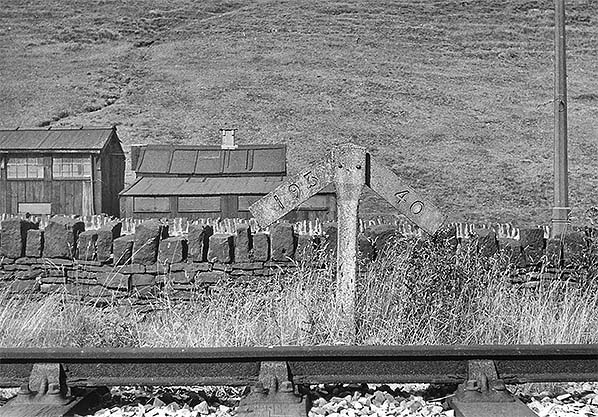 The gradient post at the summit of the Rochdale–Bacup line is seen in August 1961, looking north-east, with the ‘up’ line in the foreground. At this point there is an abrupt transition from 1 in 40, falling towards Shawforth and Rochdale and 1 in 193, falling towards Britannia station, about 250yd north-west. An LYR gradient diagram (reproduced in Wray’s book of 1989) indicates that the 1 in 193 stretch was 1 in 250. Such inconsistencies between company data and what appeared on gradient posts are common, and the precision of the figures does not necessarily indicate accuracy; settlement of the tracks and re-ballasting could result in minor changes of gradient. What is important here is that the gradients on this line were exceptionally severe, with most of the four miles between Facit and Bacup being between 1 in 34 and 1 in 40, resulting in restrictions in operating goods trains on this section The gradient post at the summit of the Rochdale–Bacup line is seen in August 1961, looking north-east, with the ‘up’ line in the foreground. At this point there is an abrupt transition from 1 in 40, falling towards Shawforth and Rochdale and 1 in 193, falling towards Britannia station, about 250yd north-west. An LYR gradient diagram (reproduced in Wray’s book of 1989) indicates that the 1 in 193 stretch was 1 in 250. Such inconsistencies between company data and what appeared on gradient posts are common, and the precision of the figures does not necessarily indicate accuracy; settlement of the tracks and re-ballasting could result in minor changes of gradient. What is important here is that the gradients on this line were exceptionally severe, with most of the four miles between Facit and Bacup being between 1 in 34 and 1 in 40, resulting in restrictions in operating goods trains on this section
Photo by Ian G Holt
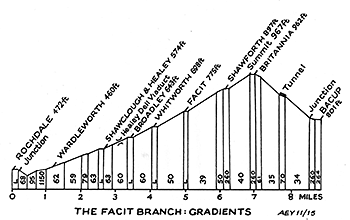 The Rochdale-Bacup branch was notorious for the severity of its gradients, equalled by few other lines on Britain’s railway network. From Rochdale there was an almost continuous climb to Facit, much of it between 1 in 50 and 1 in 60, relenting at Broadley, Whitworth and Facit where short level sections gave down trains an easier start from the stations. Leaving Facit the trains faced a savage 1 in 39 for a mile, reducing to 1 in 260 through Shawforth station, then 1 in 40 to the 967ft summit at Britannia: as noted earlier this was the highest point on the Lancashire & Yorkshire Railway. Beyond Britannia the line descended to Bacup through a 144yd tunnel (seen described as the Britannia or New Line Tunnel) and a rock cutting at the even steeper gradient of 1 in 35/34, slackening to 1 in 70 through the tunnel. Skill and concentration on the part of the enginemen was needed on these difficult gradients, but this stretch of line was relatively free of accidents. The Rochdale-Bacup branch was notorious for the severity of its gradients, equalled by few other lines on Britain’s railway network. From Rochdale there was an almost continuous climb to Facit, much of it between 1 in 50 and 1 in 60, relenting at Broadley, Whitworth and Facit where short level sections gave down trains an easier start from the stations. Leaving Facit the trains faced a savage 1 in 39 for a mile, reducing to 1 in 260 through Shawforth station, then 1 in 40 to the 967ft summit at Britannia: as noted earlier this was the highest point on the Lancashire & Yorkshire Railway. Beyond Britannia the line descended to Bacup through a 144yd tunnel (seen described as the Britannia or New Line Tunnel) and a rock cutting at the even steeper gradient of 1 in 35/34, slackening to 1 in 70 through the tunnel. Skill and concentration on the part of the enginemen was needed on these difficult gradients, but this stretch of line was relatively free of accidents.
Because of the extremely steep gradients between Facit and Bacup, goods services to and from Bacup operated via the Irwell Valley (Rawtenstall), and stone traffic originating at the quarries was the only significant freight on the Facit-Bacup section; thus it was unnecessary to provide goods warehouses at Shawforth and Britannia stations.
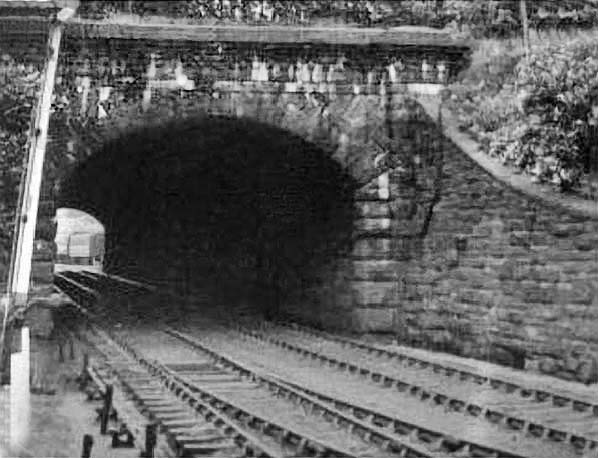 Britannia, or New Line, Tunnel. Britannia, or New Line, Tunnel.
In 1895 a project to build a goods and passenger branch from the Facit Branch received some interest. The Norden Railway would have connected this village to the Facit Branch at Wardleworth by a mile of railway, including a substantial viaduct on the route, but nothing came of it.
COMPETITION FROM TRAMS AND BUSES
The branch was busy with goods and mineral traffic, and was, in its earlier decades, a boon for the residents of the Whitworth Valley. However, the Rochdale-Bacup road accompanied it for much of its length, and although none of their stations were distant from the communities in the valley, buses could serve the residents more conveniently, operating frequently and stopping at closer intervals. As noted earlier the railway was unable to respond by increasing indefinitely the train frequency as so much of the branch was single-track. Having said this, in the 1930s the throughput of trains particularly to convey Whitworth Valley people to the cinemas in Rochdale on Saturdays was impressive. On some LYR lines additional stopping places were provided in the early twentieth century to increase the convenience of the service, with low, or rail-level, platforms and served by ‘rail-motors’ fitted with steps and manned by a conductor who issued tickets on the train from the new unstaffed halts. In 1906 a rail-motor was introduced on the branch, but it was swiftly withdrawn as it struggled with the severe gradients.
Competition for traffic from steam trams emerged in 1884 when they were introduced between Rochdale and Whitworth in 1884. In the following year the tramway was extended to Facit. However the tramway’s receipts were lower than anticipated and the route was cut back to Broadley in 1891. Rochdale Corporation took over the tramway and converted it to electric operation in 1904. Faced with this competition, as noted above, the LYR briefly used a steam rail-motor on the Facit Branch in 1906, but Wells (1992) asserts that the LYR ‘had a virtual monopoly of custom between Rochdale and Bacup’ despite the extension of Rochdale’s electric trams were to Facit in 1910 and Bacup in 1911. A disadvantage of the trams was that winter snow was more likely to cut off the main road, particularly in the Britannia area; it took a particularly severe winter to stop the railway running.
Most of the tram route ran close to the railway and, in time, a significant amount of traffic was won from the trains. Shawclough & Healey and Britannia stations closed on 2 April 1917, as a ‘wartime economy’; hundreds of Britain’s quieter stations closed in 1916-17 to release manpower for service in the forces. Most of these stations reopened after hostilities ceased. Although passenger trains called again at Shawclough & Healey from November 1919 Britannia was one of a sorry band which never reopened. Here the Rochdale-Bacup tram route ran only yards from the station, and the tramcars carried passengers bound for Bacup to the centre of the town rather than to the less conveniently-sited railway station. Sunday trains on the branch were discontinued in April 1918 and did not resume after the war, although they ran in the 1930s.
THE LMS ERA
In 1922 the Lancashire & Yorkshire Railway was absorbed by the London & North Western (LNW), in preparation for the ‘Grouping’ of January 1923 when the LNW became one of the constituents of the London, Midland & Scottish Railway (LMS). The branch engine shed at Bacup was allocated 37 locomotives at the Grouping.
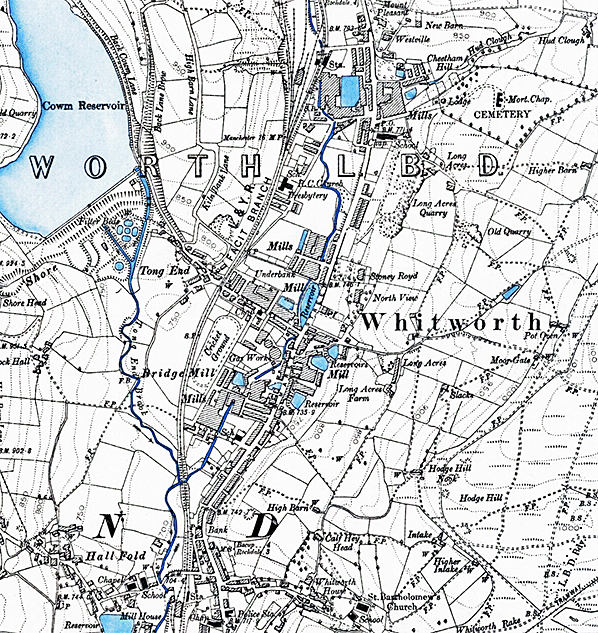 1890 1: 10,560 OS map. The linear town of Whitworth, with its many textile mills, stretches up the floor of the Spodden Valley. Its station is at the southern end of the map, complete with goods warehouse (not named), loop and siding. The single-track railway, climbing at a gradient of 1 in 50 crosses Tong Lane (where Tonge End signal box was located). At the northern end of the map is Facit station, the northern terminus of the branch from 1870 until it was opened onward to Bacup in 1881. Extensive goods and mineral sidings can be seen west of the passenger station. 1890 1: 10,560 OS map. The linear town of Whitworth, with its many textile mills, stretches up the floor of the Spodden Valley. Its station is at the southern end of the map, complete with goods warehouse (not named), loop and siding. The single-track railway, climbing at a gradient of 1 in 50 crosses Tong Lane (where Tonge End signal box was located). At the northern end of the map is Facit station, the northern terminus of the branch from 1870 until it was opened onward to Bacup in 1881. Extensive goods and mineral sidings can be seen west of the passenger station.
The LMS retained the passenger services, trains being allowed about 3½ minutes per mile from Rochdale, and a little less time in the opposite direction. Despite competition from street trams (until they were withdrawn in November 1932) and motor buses along the entire route between Rochdale and Bacup, patronage of the trains remained healthy throughout the 1930s, the line being popular with shoppers from Whitworth who typically alighted at Wardleworth from where they could walk the length of Rochdale’s two principal shopping streets (Yorkshire Street and Drake Street) and return home from Rochdale station, having generally walked downhill with their progressively heavier load of shopping. The 3d cheap day return fare on the trains compared favourably with 4d each way charged on the buses. On winter Saturdays crowded trains conveyed supporters of Rochdale AFC to and from Shawclough & Healey station. In the late 1930s the LMS was obviously making great efforts to attract passengers to the line. This was the era of regular Saturday night cinema-going, and Rochdale's many cinemas and theatre offered great opportunities to people from the Whitworth Valley. The LMS put on a very intensive Saturday evening service in the immediate pre-war years to meet this need, and the July 1938 timetable (below) gives a good insight into operating an intensive service over the single line between Wardleworth and Facit. The operating zenith of the Rochdale-Bacup line (Wells 1992) was in summer 1938 with no fewer than 21 trains between Rochdale and Bacup and seven trains each way between these stations on Sunday. Sunday services in the 1930s were provided by longitudinal-seating open coaches in which conductor-guards issued the tickets.
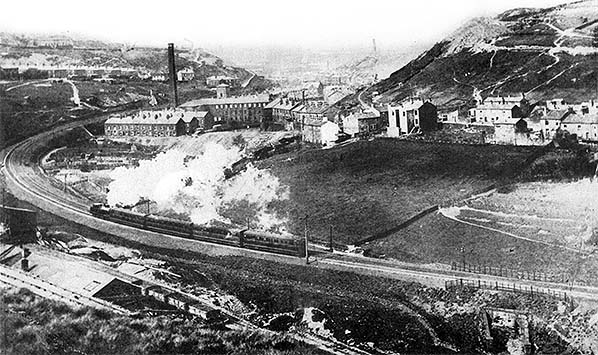 This photograph is pre-Grouping and probably before World War 1 and the view is looking north-eastwards from a point several hundred yards north of Facit station. The train is travelling towards Bacup and is about to tackle the 1 in 39 gradient up to Shawforth. It is passing the stone processing works and associated sidings. Lower left is the long siding that serves Facit Quarries. The train is headed by an Aspinall-designed radial tank, and it is running bunker-first. Wray (1989) suggests that because chimney-first running was normal for these engines it was probably because of the steep gradients on the line that the reverse practice is seen here: the water in the boiler would not uncover the firebox crown plate when the summit is reached and the engine is on the downhill stretch beyond This photograph is pre-Grouping and probably before World War 1 and the view is looking north-eastwards from a point several hundred yards north of Facit station. The train is travelling towards Bacup and is about to tackle the 1 in 39 gradient up to Shawforth. It is passing the stone processing works and associated sidings. Lower left is the long siding that serves Facit Quarries. The train is headed by an Aspinall-designed radial tank, and it is running bunker-first. Wray (1989) suggests that because chimney-first running was normal for these engines it was probably because of the steep gradients on the line that the reverse practice is seen here: the water in the boiler would not uncover the firebox crown plate when the summit is reached and the engine is on the downhill stretch beyond
Photo from Whitworth Historical Society
The ‘wakes weeks’ when the mills closed for maintenance and the workers were able to take their annual holiday (with Blackpool the favoured destination) briefly brought crowds onto the branch stations. A local resident recalls that Wardleworth station was often crowded at these times as passengers thought, wrongly, they would be more likely to find more space to stand on the platform than at Rochdale.
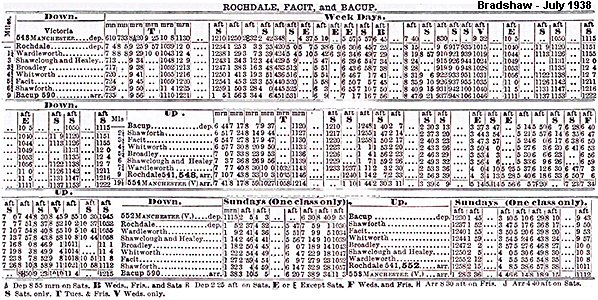
As elsewhere in Britain operating economies were made on the Facit Branch with the onset of World War 2 with a general reduction of services; for details please see the individual station pages. Significantly the Sunday trains were withdrawn, never to be reinstated, and Rochdale-Wardleworth short workings ceased.
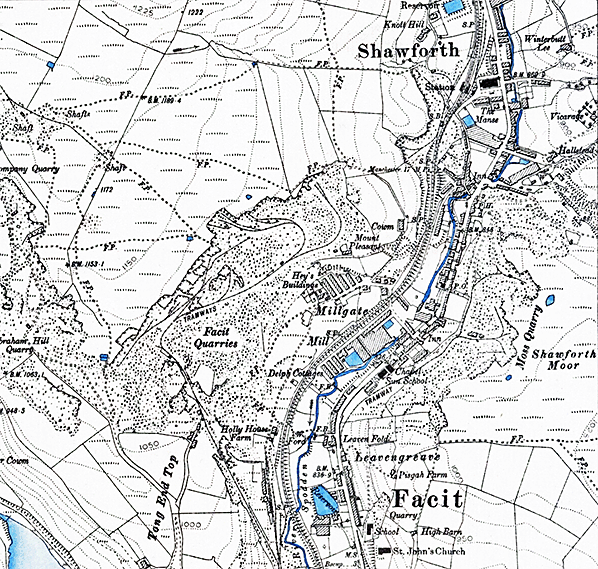
1890 1: 10,560 OS map. From Facit, whose station is immediately south of this map, the double-track railway climbs at an almost continuous gradient of 1 in 39 up the floor of the Spodden Valley to Shawforth. The valley sides and moorland to the west have been extensively quarried for the valuable flagstones, and Facit Quarries are served by a network of ‘tramways’ connected to the Facit Branch by an incline. Other mineral sidings can be seen west of the railway on the approach to Shawforth station. Moss Quarry, on the eastern side of the valley, is also served by a tramway, but this is not linked to the Facit Branch
During World War 2 several sidings were laid on the up side between Healey Dell Viaduct and Broadley station to serve an explosives factory. Both the factory and sidings were dismantled after the war, but the site of the sidings is still discernible today.
THE END OF PASSENGER SERVICES
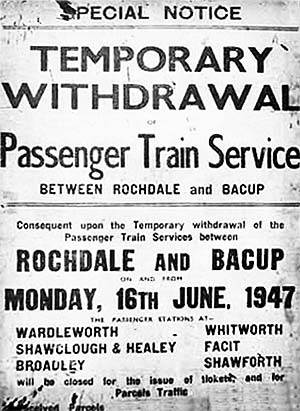 Declining traffic and the ‘coal crisis’ gave the LMS a convenient opportunity to announce that the passenger services between Rochdale and Bacup would be suspended from 16 June 1947. In the company’s own words, ‘the serious coal position has forced the company to discontinue certain services in order to conserve fuel supplies’. The LMS emphasised the ‘utmost urgency’ of the measure and was satisfied that Rochdale Corporation Passenger Transport, having been given the full figures of travelling public using the line, ‘would be able to deal with future requirements’. This news reached the local council in Whitworth and the Corporations of Bacup and Rochdale on Wednesday 16 April, and Stationmaster J Armitage of Rochdale swiftly confirmed the information, assuring the authorities that the goods services would continue without alteration. One of the councillors remarked that it had taken a long time for them [the LMS] to make up their minds and that they had been ‘running empty trains practically empty for long enough’. The Whitworth Town Clerk swiftly sent a letter expressing concern to the LMS, and by 24 April a deputation had visited the Ministry of Transport to put the case for the district in the strongest possible terms. Cllr Penney (correctly) opined, ‘if Whitworth loses the railway they lose it for good’. However, Rochdale Observer of 24 April carried a report that the stationmaster at Whitworth had received a notification from the LMS rescinding the order to cease bookings as from 14 June, giving the impression that the closure was still not a foregone conclusion, and he informed a local councillor that if the service were suspended it would resume in October. Bacup Times of the same date carries a reported reassurance by Alfred Barnes, Minister of Transport: ‘The withdrawal of the passenger service is a temporary measure designed to save fuel,’ though with the warning, ‘I understand that the trains are lightly loaded and that adequate alternative public transport exists’. Declining traffic and the ‘coal crisis’ gave the LMS a convenient opportunity to announce that the passenger services between Rochdale and Bacup would be suspended from 16 June 1947. In the company’s own words, ‘the serious coal position has forced the company to discontinue certain services in order to conserve fuel supplies’. The LMS emphasised the ‘utmost urgency’ of the measure and was satisfied that Rochdale Corporation Passenger Transport, having been given the full figures of travelling public using the line, ‘would be able to deal with future requirements’. This news reached the local council in Whitworth and the Corporations of Bacup and Rochdale on Wednesday 16 April, and Stationmaster J Armitage of Rochdale swiftly confirmed the information, assuring the authorities that the goods services would continue without alteration. One of the councillors remarked that it had taken a long time for them [the LMS] to make up their minds and that they had been ‘running empty trains practically empty for long enough’. The Whitworth Town Clerk swiftly sent a letter expressing concern to the LMS, and by 24 April a deputation had visited the Ministry of Transport to put the case for the district in the strongest possible terms. Cllr Penney (correctly) opined, ‘if Whitworth loses the railway they lose it for good’. However, Rochdale Observer of 24 April carried a report that the stationmaster at Whitworth had received a notification from the LMS rescinding the order to cease bookings as from 14 June, giving the impression that the closure was still not a foregone conclusion, and he informed a local councillor that if the service were suspended it would resume in October. Bacup Times of the same date carries a reported reassurance by Alfred Barnes, Minister of Transport: ‘The withdrawal of the passenger service is a temporary measure designed to save fuel,’ though with the warning, ‘I understand that the trains are lightly loaded and that adequate alternative public transport exists’.
Rochdale Observer on 14 May 1947 reported that Bacup Corporation was to request the LMS to consider the possibility of continuing the service and to charge cheaper fares. This, of course, cut no ice with the LMS, and the Ministry of Transport had already indicated that fare reduction was not an option. The matter of fares was a valid point. Before the war passengers could travel from Bacup to Wardleworth (for Rochdale town centre) at 7d single or 9d return, whilst in 1947 the fares had soared to 1s 11d and 2s 3d respectively.
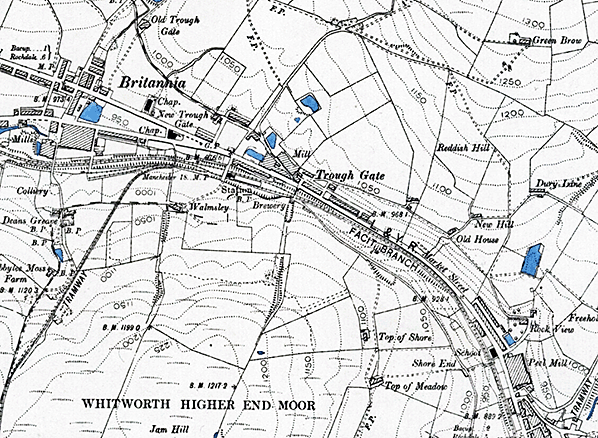
1890 1: 10,560 OS map. The Facit Branch climbs to its summit of 967ft a short distance south-east of Trough Gate, approached from the south at a gradient of 1 in 40. At this point the line leaves the valley of the Spodden and begins its descent into the Irwell Valley. A short distance west of Britannia station (shown simply as ‘Station’) a tramway is shown striking south-south-west onto the moors; this served the huge Britannia Quarries, noted for the extraction of flagstones. Because of the severe gradients either side of Britannia, goods trains did not generally use the route between Facit and Bacup, but it was used by trains carrying flagstones. Settlement in this area is somewhat sparser than elsewhere along the railway’s route, and Britannia station was to close as early as 1917
Contents of the Bacup Times in the weeks between the announcement of the suspension of train services and the implementation of the threat suggest a muted response at that end of the line. Significantly, during this period the only two letters published on the subject were from the same man, a Mr B Butterworth, who (on 17 May) encouraged the local people to fight the closure ‘tooth and nail’ and (on 24 May) questioned the assurance of the Ministry of Transport that buses could adequately soak up the displaced passengers at such places as Shawforth where every weekend, from Saturday noon, they found the buses arrive already full. He pointed out, accurately as it happened, that just as the temporary closure of Britannia station proved to be permanent, the same would now happen to the Rochdale-Bacup line. Mr Butterworth was Branch Secretary of ASLEF, the drivers’ and firemen’s union. His suggestion that a push-and-pull ‘running a skeleton service’ might be a solution probably would appeal neither to his colleagues in the union nor the travelling public who had already drifted from the trains to the more frequent and convenient buses.
The closure went ahead as originally announced, with the final train running on Saturday 16 June 1947, the formal ‘suspension’ taking effect two days later. Rochdale Observer reported efficiently on 18 June: ‘The 10.40pm on Saturday was the last passenger train to run from Rochdale to Bacup. In future the line will be used by goods traffic only. Few people boarded the train at Rochdale and everyone seemed to take the event very calmly’. The last train consisted of two coaches hauled by a Stanier ‘Class 3’ 2-6-2 tank. A somewhat longer piece was carried in Bacup Times on 21 June: ‘Apart from a Times reporter’ it begins, ‘who was “on the spot” for the outgoing and incoming last trains, the only people on the platform when the 7.55pm train pulled out were five railway employees and two little girls, though a couple of photographers were perched on a signal platform. Passengers numbered no more than three, all from Rochdale, who were travelling simply for the “novelty” of the occasion. The crew of the train were Mr W Higgins (Driver) and Mr R D Noon (Fireman), both of Newton Heath, and Mr W Jones (Guard) of Rochdale. Of the 18 passengers who alighted from the last train at Bacup, at least two had made a special point of being on it in view of the circumstances …. it was Mr Bancroft [of Rochdale Road, Bacup] who had the distinction of purchasing the last ticket issued in the ordinary way as a memento of the occasion. He [and a Mr Holt] bought two tickets so that they might retain one. Mr F Howorth (Porter) collected the final tickets.’
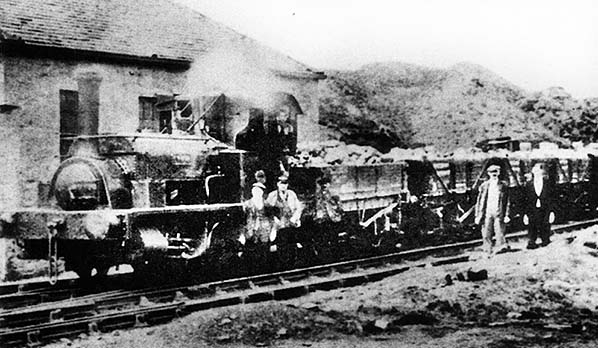 The loco named ‘Lymm’ is seen at Facit Quarries at an unknown date. Research by Wells (1993) has established that the loco was built by Hunslet (Leeds) in 1888, and her first duties were in connection with the construction of the Manchester Ship Canal when owned by T A Walker. About 1900 she was transferred from Stacksteads to Facit Quarries and fell into the ownership of Heys Bros and Sanderson. ‘Lymm’ worked most days, hauling and shunting wagons around the network of lines serving the moor top quarries. After the rope-worked incline was lifted in 1947 and the quarries closed, the loco was left stranded on the tops before being scrapped sometime between October 1959 and February 1960.
Photo from Lancashire County Library, Rossendale District and Jeffrey Wells
Whitworth Council accepted that ‘for the time being’ railway passenger services had ended but resolved to approach the LMS for an assurance that ‘essential commodities’ would continue to be carried on the line, especially perishable goods. Rochdale Observer reported on 21 June that within days of the end of passenger services the Whitworth Council had received complaints from shopkeepers dealing in fish that their supplies had not arrived, and that one of their members had been compelled to collect consignments from Rochdale station and ‘bring it by motor’ to retailers in the district. The only alternative was to wait until the afternoon for supplies to arrive, by which time customers no longer wanted to buy the fish. In the same edition of the paper it emerged that Whitworth Council’s Town Clerk had contacted Bacup Corporation with a view to a joint protest at the closure, but that Bacup, while appreciating Whitworth’s offer of co-operation, considered that nothing could be done and they should ‘bow to the inevitable’. Bacup, of course, still had a train service via the Irwell Valley; Whitworth now had none.
At the same time that the Facit Branch closed a number of LMS lines (such as the Stroud and Nailsworth branches in Gloucestershire) suffered this fate for the same reason. J J Bramhill, stationmaster at Facit, later confided (to Ian Holt, who has published material on the Facit Branch and assisted with this article) that the end of the passenger service came as no surprise to him as no-one was using it. The line became part of British Railways’ London Midland Region on 1 January 1948, and under the new administration the decision not to reinstate the passenger trains was announced on 14 December 1949. However, Bacup continued to be served by frequent trains on the Irwell Valley branch.
THE BRITISH RAILWAYS YEARS
As noted earlier, the northern section of the line between Facit and Bacup was not a goods route because of the steep gradients, and after the war stone traffic on this section had dwindled to such a degree that it closed on 5 May 1952 between Facit and Bacup engine shed (LMS 26E). In its latter years Facit-Bacup was used for ‘light engine’ movement (engines drawing no wagons or coaches) to and from Bacup engine shed. After closure between Facit and Bacup, for the short time that Bacup shed remained open, light engines worked via the Irwell Valley. The demise of passenger services between Rochdale and Bacup brought about a reduction in the shed’s locomotive allocation, and with only eight in residence it closed on 10 October 1954 together with the short section of line to Bacup Junction. Seven locos were transferred to Bury and one was withdrawn. Rails between Facit and Bacup remained in place, notionally available for wagon storage, though only a short length within the passenger platforms and sidings at Facit were ever actually used for this purpose.
 During the time that the Facit-Bacup line was in its comatose state, the area between Britannia and Bacup shed was used in a short sequence of the film Whistle Down the Wind of 1961, directed by Bryan Forbes: the film was largely made in the village of Downham at the foot of Pendle Hill, about 15 miles to the north, but the railway sequence used the cutting east of the New Line Tunnel at Bacup shed and is followed by a shot in which the derelict Bacup Engine Shed signal box appears. Click here to watch the film (99 minutes) During the time that the Facit-Bacup line was in its comatose state, the area between Britannia and Bacup shed was used in a short sequence of the film Whistle Down the Wind of 1961, directed by Bryan Forbes: the film was largely made in the village of Downham at the foot of Pendle Hill, about 15 miles to the north, but the railway sequence used the cutting east of the New Line Tunnel at Bacup shed and is followed by a shot in which the derelict Bacup Engine Shed signal box appears. Click here to watch the film (99 minutes)
The goods and minerals traffic levels held into the 1950s with twice-daily goods trains between Rochdale and Facit - typically with coal inbound to rail-served factories and outbound consignments of stone – but during that decade several firms along the route ceased to use their sidings, including Bright’s and Rochdale Brick Co (between Wardleworth and Shawclough) both of whose sidings closed in 1956.
Some excursions visited the line after regular passenger services were withdrawn. The ‘Old Manchester Rail Tour’ was one such excursion, organised jointly by the Stephenson and Manchester Locomotive Societies, when on 12 May 1956 locomotives Nos.80088 and 92438 hauled a 5-coach train from Rochdale to Facit and No.50647 brought it back to Rochdale. On 28 July 1962 the Roch Valley Railway Society’s ‘Salford Hundred Railtour’ visited Facit, hauled there by No.52523 and returning to Rochdale behind No.40063.
From 10 November 1956 the branch north of Wardleworth signal box was worked on a ‘One Engine in Steam’ basis, and the boxes at Broadley and Facit Goods Yard were closed. Tonge End box, between Whitworth and Facit, controlling the line’s only manned level crossing, closed at the same time.
In 1960 the short double-track section at the southern end of the line was singled, with the abandonment of the up line between Rochdale and Wardleworth. Thereafter the connection to the branch (and to the extensive coal yard that formed Branch Sidings) was via the down goods loop from Rochdale East Junction. On 12 August 1963 the line was cut back to Whitworth and the remaining track north of this station was abandoned; this included the notional wagon-storage section between Facit and Bacup. The rails from Whitworth to Bacup were removed by the end of 1964. However, misleadingly the OS 1: 10,560 map published in 1967 shows the double-track line all the way from Facit to Bacup still in place, described as ‘Disused Railway’. The survey for this map was presumably carried out some years before its publication.
BRITISH RAIL AND THE END OF THE LINE
The Locomotive Club of Great Britain ‘Middleton Branch Brakevan Tour’ travelled the full length of the remaining route on 7 August 1965. This train consisted of nine brake vans but on its northbound journey it stalled on the 1 in 59/62 gradient north of Wardleworth, and the loco propelled its load back to Wardleworth where five of the vans were detached. The four remaining vans completed the journey to Whitworth and back to Wardleworth, where the train was re-formed to the full nine vans. From 27 February 1966 the entire route between the Branch Sidings and the terminus at Whitworth was operated on a ‘One Engine in Steam’ basis; Rochdale Branch Sidings signal box closed at the same time. On 19 February 1967 the LCGB and Roch Valley Railway Society organised the ‘L&Y Pug Rail Tour’ to visit the surviving section. Three round trips were made between Rochdale and Whitworth; four brake vans were hauled by No.51218 and intermediate photo-stops were made at Wardleworth and Shawclough & Healey stations.
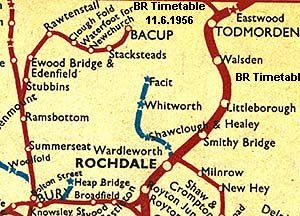 In its final freight-only years the branch was worked by Ivatt ‘2MT’ 2-6-0s and Stanier 4-6-0s, with the occasional appearance of Fowler ‘4F’ 0-6-0s. The last few months saw a 350hp diesel in action. Type 2 (Class 25) main line diesels paid several visits with the Newton Heath tool van when there was a derailment in one of the sidings at Shawclough & Healey. Turner Bros’ asbestos works at Shawclough & Healey was the most important user of the railway, and it was the termination of this traffic which brought about the abandonment of the branch on 21 August 1967; north of Shawclough, Taylor’s coal business at Whitworth had justified retention of the line to that station. Three days earlier, on Friday 18 August, a final LCGB (NW Branch) tour travelled up to Whitworth, on a train comprising three brake vans and several wagons hauled by D3845. Because closure of freight lines did not require the official public notification given for passenger service withdrawals, there was limited time for the LCGB to organise the tour, which was not advertised in Railway Magazine, where announcements about forthcoming tours were normally published; moreover, the use of only two brake vans would severely limit the number of passengers that could be safely accommodated. In its final freight-only years the branch was worked by Ivatt ‘2MT’ 2-6-0s and Stanier 4-6-0s, with the occasional appearance of Fowler ‘4F’ 0-6-0s. The last few months saw a 350hp diesel in action. Type 2 (Class 25) main line diesels paid several visits with the Newton Heath tool van when there was a derailment in one of the sidings at Shawclough & Healey. Turner Bros’ asbestos works at Shawclough & Healey was the most important user of the railway, and it was the termination of this traffic which brought about the abandonment of the branch on 21 August 1967; north of Shawclough, Taylor’s coal business at Whitworth had justified retention of the line to that station. Three days earlier, on Friday 18 August, a final LCGB (NW Branch) tour travelled up to Whitworth, on a train comprising three brake vans and several wagons hauled by D3845. Because closure of freight lines did not require the official public notification given for passenger service withdrawals, there was limited time for the LCGB to organise the tour, which was not advertised in Railway Magazine, where announcements about forthcoming tours were normally published; moreover, the use of only two brake vans would severely limit the number of passengers that could be safely accommodated.
AFTER CLOSURE
The closure of this line took place only a few months after the abandonment of the Irwell Valley branch from Rawtenstall to Bacup on 5 December 1966.
The rails between Rochdale and Whitworth were swiftly removed by the end of 1967.Within three years Cowm Park Way was built on the railway trackbed between the sites of Whitworth and Facit stations.
After track-lifting some of the major engineering features of the route were removed. Roch Viaduct, which had proved troublesome to build, was more obliging when its demolition was in hand. On 11 July 1972 when contractors were conducting a test explosion on one arch a chain reaction was set off, and 11 arches unexpectedly collapsed, blocking Entwistle Road and fracturing gas and water mains in the process. Removal of the nearby Yorkshire Street bridge was less eventful. Most of the station buildings and platforms had been demolished by the 1980s, leaving only Broadley’s platform in situ, and the former subway at Shawforth station remains in use within a small residential estate. The station cottages at Shawclough & Healey – which were existing houses adopted by the railway – are in residential use, but the station itself has long been demolished and housing occupies its site. At Britannia the former cutting and station site have been infilled. The finest surviving feature of the branch is Healey Dell Viaduct, which strides majestically over the deep, wooded valley, and much of the trackbed between Shawclough & Healey and Britannia is a recreational path, the section at Healey Dell and Broadley being particularly delightful. The survival of the viaduct is, in part, attributable to its valuable but less than glamorous role of carrying a sewer from Whitworth to Rochdale.

1890 1: 10,560 OS map. On this map the double-track Rochdale – Bacup ‘Facit Branch’ railway is seen descending from Britannia (a short distance east of this map) to Bacup at a gradient of 1 in 34/35, slackening to 1 in 70 through the short short Britannia, or New Line, Tunnel (close to Lower Slack). The road running to the south is named ‘New Line’, referring to the adjacent railway. Bacup Engine Shed is named and its associated sidings are shown. At the western edge of the map the Facit Branch joins the ‘old line’ route from Bury and Rawtenstall a little south of Bacup station. Although the town of Bacup is largely confined to the floor of the River Irwell Valley, a couple of mills and some terraced housing are seen alongside the Facit Branch
The railway has now gone, but from its public transport successor, the quarter-hourly 464 Rosso bus between Rochdale and Bacup (it continues to Accrington) tantalising glimpses of the railway route can still be had, particularly between Shawforth and Britannia.
ACKNOWLEDGEMENTS
I am grateful to Ian Holt for permission to use many of his photographs and for providing a wealth of information in numerous exchanges of e-mails; some of the more erudite photo captions are the result of his contributions. Jeff Wells and Tom Wray, both of whom have written scholarly histories of the line, have provided invaluable help. Richard Greenwood has kindly allowed me to include some of his photographs and provided information about them. Darren Kitson, author of some of the ‘Disused Stations’ pages, has helped with identification of motive power and rolling stock. The staff of Touchstones Arts & Heritage Centre local studies department (Rochdale), Bacup Library, Bacup Natural History Society Museum and Derek Lord, Cheryl Stewart and Paula Bradbury of Whitworth Historical Society have provided help too.
BIBLIOGRAPHY:
- Biddle, Gordon Britain’s historic railway buildings (Oxford University Press, 2003
- Biddle, Gordon Victorian stations (David & Charles, 1973)
- Bowden, K F The book of Bacup (Quotes Ltd, 1994)
- Bury Transport Museum Journal Winter/Spring 1980
- Christiansen, Rex ‘Pennine anniversaries’ (Railway Magazine, July 1977); corrections and additions to this article in Railway Magazine, October 1977)
- Clinker C R Clinker’s register of closed passenger stations and goods depots (Avon Anglia 1978)
- Coward, Andrew The decline of British Railways in Bury & Rossendale (Author, 2013)
- Earnshaw, Alan Pennine Branch Lines (Ian Allan 1993)
- Littleworth, Chris Signal boxes on Lancashire & Yorkshire Railway lines: north and west of Manchester: Part 2 (Lancashire & Yorkshire Railway Society 2014)
- Marshall, John The Lancashire & Yorkshire Railway Vols 1 and2 (David & Charles, 1969, 1970)
- Nadin, Jack The Rossendale Coalfield (The History Press, 2012)
- Porter, John The making of the Central Pennines (Moorland Publishing Co, 1980)
- Quick, Michael Railway passenger stations in Great Britain: a chronology (RCHS 2009)
- Robertson, William Rochdale and the Vale of Whitworth (1897, reprinted by Kelsall 1992)
- Wells, Jeffrey An illustrated history of Rochdale’s railways (Irwell Press, 1993)
- Wells, Jeffrey An illustrated historical survey of the railways in and around Bury (Challenger, 1995)
- Wray, Tom Branchlines of the Lancashire & Yorkshire Railway: No.7 The Bacup Branch (L&YR Society 1989)
- Wray, Tom ‘The Facit Branch of the Lancashire & Yorkshire Railway’ (Backtracks Vol.19 No.5 May 2005)
- Wray, Tom The Bacup Branch: a history of the railway in Whitworth (Whitworth Historical Society, 2012)
- Rochdale Observer (Microfilm held in Touchstones Centre, Rochdale)
- Bacup Times (Copies held in Bacup Natural History Society Museum)
To see stations on the Bacup - Rochdale line click on the station name: Britannia, Shawforth, Facit, Whitworth, Broadley, Shawclough & Healey, Wardleworth & Rochdale (First station)
| Last
updated: Friday, 12-Jan-2018 12:30:59 CET |
© 1998-2016 Disused Stations
| |











 Tonge End (Tong Lane) crossing was midway between Whitworth and Facit stations on the Rochdale-Bacup line. The attractive two-storey stone building with its overhanging roof and arched openings is the crossing keeper’s house (now demolished). The crossing was originally worked from the keeper's house on the east side of the line, but a substantial wooden LYR signal box was provided in 1899 on the west side. The crossing keeper's house remained after the box had been decommissioned. In this north-westward view on 21 July 1962 No.43903 is travelling towards Facit from Whitworth. The loco is a Fowler-designed 4F 0-6-0, built by the Midland Railway in April 1920 at Derby works. Numbered 3903 in LMS ownership the ‘4’ prefix was added by British Railways. No.43903 was withdrawn from 16C, Kirkby-in-Ashfield shed, on 9 May 1964 and cut up by Slag Reduction Co Ltd, Ickles, Rotherham
Tonge End (Tong Lane) crossing was midway between Whitworth and Facit stations on the Rochdale-Bacup line. The attractive two-storey stone building with its overhanging roof and arched openings is the crossing keeper’s house (now demolished). The crossing was originally worked from the keeper's house on the east side of the line, but a substantial wooden LYR signal box was provided in 1899 on the west side. The crossing keeper's house remained after the box had been decommissioned. In this north-westward view on 21 July 1962 No.43903 is travelling towards Facit from Whitworth. The loco is a Fowler-designed 4F 0-6-0, built by the Midland Railway in April 1920 at Derby works. Numbered 3903 in LMS ownership the ‘4’ prefix was added by British Railways. No.43903 was withdrawn from 16C, Kirkby-in-Ashfield shed, on 9 May 1964 and cut up by Slag Reduction Co Ltd, Ickles, Rotherham The gradient post at the summit of the Rochdale–Bacup line is seen in August 1961, looking north-east, with the ‘up’ line in the foreground. At this point there is an abrupt transition from 1 in 40, falling towards Shawforth and Rochdale and 1 in 193, falling towards Britannia station, about 250yd north-west. An LYR gradient diagram (reproduced in Wray’s book of 1989) indicates that the 1 in 193 stretch was 1 in 250. Such inconsistencies between company data and what appeared on gradient posts are common, and the precision of the figures does not necessarily indicate accuracy; settlement of the tracks and re-ballasting could result in minor changes of gradient. What is important here is that the gradients on this line were exceptionally severe, with most of the four miles between Facit and Bacup being between 1 in 34 and 1 in 40, resulting in restrictions in operating goods trains on this section
The gradient post at the summit of the Rochdale–Bacup line is seen in August 1961, looking north-east, with the ‘up’ line in the foreground. At this point there is an abrupt transition from 1 in 40, falling towards Shawforth and Rochdale and 1 in 193, falling towards Britannia station, about 250yd north-west. An LYR gradient diagram (reproduced in Wray’s book of 1989) indicates that the 1 in 193 stretch was 1 in 250. Such inconsistencies between company data and what appeared on gradient posts are common, and the precision of the figures does not necessarily indicate accuracy; settlement of the tracks and re-ballasting could result in minor changes of gradient. What is important here is that the gradients on this line were exceptionally severe, with most of the four miles between Facit and Bacup being between 1 in 34 and 1 in 40, resulting in restrictions in operating goods trains on this section The Rochdale-Bacup branch was notorious for the severity of its gradients, equalled by few other lines on Britain’s railway network. From Rochdale there was an almost continuous climb to Facit, much of it between 1 in 50 and 1 in 60, relenting at Broadley, Whitworth and Facit where short level sections gave down trains an easier start from the stations. Leaving Facit the trains faced a savage 1 in 39 for a mile, reducing to 1 in 260 through Shawforth station, then 1 in 40 to the 967ft summit at Britannia: as noted earlier this was the highest point on the Lancashire & Yorkshire Railway. Beyond Britannia the line descended to Bacup through a 144yd tunnel (seen described as the Britannia or New Line Tunnel) and a rock cutting at the even steeper gradient of 1 in 35/34, slackening to 1 in 70 through the tunnel. Skill and concentration on the part of the enginemen was needed on these difficult gradients, but this stretch of line was relatively free of accidents.
The Rochdale-Bacup branch was notorious for the severity of its gradients, equalled by few other lines on Britain’s railway network. From Rochdale there was an almost continuous climb to Facit, much of it between 1 in 50 and 1 in 60, relenting at Broadley, Whitworth and Facit where short level sections gave down trains an easier start from the stations. Leaving Facit the trains faced a savage 1 in 39 for a mile, reducing to 1 in 260 through Shawforth station, then 1 in 40 to the 967ft summit at Britannia: as noted earlier this was the highest point on the Lancashire & Yorkshire Railway. Beyond Britannia the line descended to Bacup through a 144yd tunnel (seen described as the Britannia or New Line Tunnel) and a rock cutting at the even steeper gradient of 1 in 35/34, slackening to 1 in 70 through the tunnel. Skill and concentration on the part of the enginemen was needed on these difficult gradients, but this stretch of line was relatively free of accidents. Britannia, or New Line, Tunnel.
Britannia, or New Line, Tunnel.  1890 1: 10,560 OS map. The linear town of Whitworth, with its many textile mills, stretches up the floor of the Spodden Valley. Its station is at the southern end of the map, complete with goods warehouse (not named), loop and siding. The single-track railway, climbing at a gradient of 1 in 50 crosses Tong Lane (where Tonge End signal box was located). At the northern end of the map is Facit station, the northern terminus of the branch from 1870 until it was opened onward to Bacup in 1881. Extensive goods and mineral sidings can be seen west of the passenger station.
1890 1: 10,560 OS map. The linear town of Whitworth, with its many textile mills, stretches up the floor of the Spodden Valley. Its station is at the southern end of the map, complete with goods warehouse (not named), loop and siding. The single-track railway, climbing at a gradient of 1 in 50 crosses Tong Lane (where Tonge End signal box was located). At the northern end of the map is Facit station, the northern terminus of the branch from 1870 until it was opened onward to Bacup in 1881. Extensive goods and mineral sidings can be seen west of the passenger station. This photograph is pre-Grouping and probably before World War 1 and the view is looking north-eastwards from a point several hundred yards north of Facit station. The train is travelling towards Bacup and is about to tackle the 1 in 39 gradient up to Shawforth. It is passing the stone processing works and associated sidings. Lower left is the long siding that serves Facit Quarries. The train is headed by an Aspinall-designed radial tank, and it is running bunker-first. Wray (1989) suggests that because chimney-first running was normal for these engines it was probably because of the steep gradients on the line that the reverse practice is seen here: the water in the boiler would not uncover the firebox crown plate when the summit is reached and the engine is on the downhill stretch beyond
This photograph is pre-Grouping and probably before World War 1 and the view is looking north-eastwards from a point several hundred yards north of Facit station. The train is travelling towards Bacup and is about to tackle the 1 in 39 gradient up to Shawforth. It is passing the stone processing works and associated sidings. Lower left is the long siding that serves Facit Quarries. The train is headed by an Aspinall-designed radial tank, and it is running bunker-first. Wray (1989) suggests that because chimney-first running was normal for these engines it was probably because of the steep gradients on the line that the reverse practice is seen here: the water in the boiler would not uncover the firebox crown plate when the summit is reached and the engine is on the downhill stretch beyond

 Declining traffic and the ‘coal crisis’ gave the LMS a convenient opportunity to announce that the passenger services between Rochdale and Bacup would be suspended from 16 June 1947. In the company’s own words, ‘the serious coal position has forced the company to discontinue certain services in order to conserve fuel supplies’. The LMS emphasised the ‘utmost urgency’ of the measure and was satisfied that Rochdale Corporation Passenger Transport, having been given the full figures of travelling public using the line, ‘would be able to deal with future requirements’. This news reached the local council in Whitworth and the Corporations of Bacup and Rochdale on Wednesday 16 April, and Stationmaster J Armitage of Rochdale swiftly confirmed the information, assuring the authorities that the goods services would continue without alteration. One of the councillors remarked that it had taken a long time for them [the LMS] to make up their minds and that they had been ‘running empty trains practically empty for long enough’. The Whitworth Town Clerk swiftly sent a letter expressing concern to the LMS, and by 24 April a deputation had visited the Ministry of Transport to put the case for the district in the strongest possible terms. Cllr Penney (correctly) opined, ‘if Whitworth loses the railway they lose it for good’. However, Rochdale Observer of 24 April carried a report that the stationmaster at Whitworth had received a notification from the LMS rescinding the order to cease bookings as from 14 June, giving the impression that the closure was still not a foregone conclusion, and he informed a local councillor that if the service were suspended it would resume in October. Bacup Times of the same date carries a reported reassurance by Alfred Barnes, Minister of Transport: ‘The withdrawal of the passenger service is a temporary measure designed to save fuel,’ though with the warning, ‘I understand that the trains are lightly loaded and that adequate alternative public transport exists’.
Declining traffic and the ‘coal crisis’ gave the LMS a convenient opportunity to announce that the passenger services between Rochdale and Bacup would be suspended from 16 June 1947. In the company’s own words, ‘the serious coal position has forced the company to discontinue certain services in order to conserve fuel supplies’. The LMS emphasised the ‘utmost urgency’ of the measure and was satisfied that Rochdale Corporation Passenger Transport, having been given the full figures of travelling public using the line, ‘would be able to deal with future requirements’. This news reached the local council in Whitworth and the Corporations of Bacup and Rochdale on Wednesday 16 April, and Stationmaster J Armitage of Rochdale swiftly confirmed the information, assuring the authorities that the goods services would continue without alteration. One of the councillors remarked that it had taken a long time for them [the LMS] to make up their minds and that they had been ‘running empty trains practically empty for long enough’. The Whitworth Town Clerk swiftly sent a letter expressing concern to the LMS, and by 24 April a deputation had visited the Ministry of Transport to put the case for the district in the strongest possible terms. Cllr Penney (correctly) opined, ‘if Whitworth loses the railway they lose it for good’. However, Rochdale Observer of 24 April carried a report that the stationmaster at Whitworth had received a notification from the LMS rescinding the order to cease bookings as from 14 June, giving the impression that the closure was still not a foregone conclusion, and he informed a local councillor that if the service were suspended it would resume in October. Bacup Times of the same date carries a reported reassurance by Alfred Barnes, Minister of Transport: ‘The withdrawal of the passenger service is a temporary measure designed to save fuel,’ though with the warning, ‘I understand that the trains are lightly loaded and that adequate alternative public transport exists’.
 During the time that the Facit-Bacup line was in its comatose state, the area between Britannia and Bacup shed was used in a short sequence of the film Whistle Down the Wind of 1961, directed by
During the time that the Facit-Bacup line was in its comatose state, the area between Britannia and Bacup shed was used in a short sequence of the film Whistle Down the Wind of 1961, directed by  In its final freight-only years the branch was worked by Ivatt ‘2MT’ 2-6-0s and Stanier 4-6-0s, with the occasional appearance of Fowler ‘4F’ 0-6-0s. The last few months saw a 350hp diesel in action. Type 2 (Class 25) main line diesels paid several visits with the Newton Heath tool van when there was a derailment in one of the sidings at Shawclough & Healey. Turner Bros’ asbestos works at Shawclough & Healey was the most important user of the railway, and it was the termination of this traffic which brought about the abandonment of the branch on 21 August 1967; north of Shawclough, Taylor’s coal business at Whitworth had justified retention of the line to that station. Three days earlier, on Friday 18 August, a final LCGB (NW Branch) tour travelled up to Whitworth, on a train comprising three brake vans and several wagons hauled by D3845. Because closure of freight lines did not require the official public notification given for passenger service withdrawals, there was limited time for the LCGB to organise the tour, which was not advertised in Railway Magazine, where announcements about forthcoming tours were normally published; moreover, the use of only two brake vans would severely limit the number of passengers that could be safely accommodated.
In its final freight-only years the branch was worked by Ivatt ‘2MT’ 2-6-0s and Stanier 4-6-0s, with the occasional appearance of Fowler ‘4F’ 0-6-0s. The last few months saw a 350hp diesel in action. Type 2 (Class 25) main line diesels paid several visits with the Newton Heath tool van when there was a derailment in one of the sidings at Shawclough & Healey. Turner Bros’ asbestos works at Shawclough & Healey was the most important user of the railway, and it was the termination of this traffic which brought about the abandonment of the branch on 21 August 1967; north of Shawclough, Taylor’s coal business at Whitworth had justified retention of the line to that station. Three days earlier, on Friday 18 August, a final LCGB (NW Branch) tour travelled up to Whitworth, on a train comprising three brake vans and several wagons hauled by D3845. Because closure of freight lines did not require the official public notification given for passenger service withdrawals, there was limited time for the LCGB to organise the tour, which was not advertised in Railway Magazine, where announcements about forthcoming tours were normally published; moreover, the use of only two brake vans would severely limit the number of passengers that could be safely accommodated. 

 Home Page
Home Page